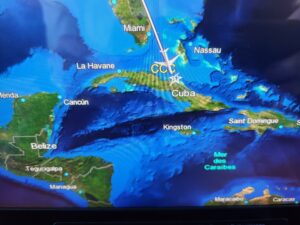
On October 21st I headed out on my very first adventure to Cuba. I was thrilled to travel there. Cuban culture is near and dear to me having lived most of my life in Miami, Florida. The food, the music, the Cuban ethos – it’s filled with warmth and passion. I was excited at the prospect of finally visiting Havanna. However, once I started doing the homework, I realized my options were limited.
Most fly fishing destination trips include 6 days of fishing plus 2 days for travel on either end. Since I’m originally from South Florida, any opportunity to fly through Miami, spend a night there and have dinner with old friends, is a welcomed one. There are direct flights to Havanna from Miami so I figured this would be easy and fun. Once I started to make flight arrangements though, I discovered a few challenges. Havanna sits on the north side of the north western part of the island. Our fly fishing destination was on the north side of the south western part of the island, an island that is 750 miles long. Cuba is currently not offering any domestic flights. My only option to get to the fishing destination from Havanna was a 9hr bus ride. If I would be spending an entire day on a bus, there would no time to explore the city. I didn’t have extra time on my calendar so sadly, Havanna was out.
Instead, travel plans were made to fly to Montreal, spend the night there, then take an early morning direct flight to Caye Coco. Each leg of the journey was about a 3.5hr flight, which in my book, is very tolerable. Once in Caye Coco, a 1hr taxi ride would get me to the resort and I’d be in my room by about 2pm.
Notice I said resort, not fishing lodge. Accomodations were at the Level Coral, Esmerelda Resort which is where the fly fishing operation is based out of. It is owned by an Italian company and serves worldwide vacationer but mostly Canadians and Russians. The rooms were beautiful, the common areas stylish and there were several restaurants and bars to enjoy. Heck, there was even a spa, multiple pools, not to mention a fantastic, fine, white-sand beach complete with lounge chairs and polapas. Not what you typically expect when destination fishing…even in high-end lodges.


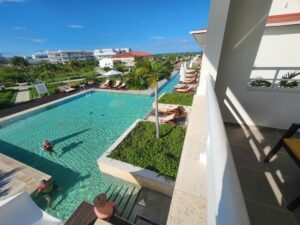
The day I arrived Boris, the on-site manager for Avalon (the company that owns the fly fishing operation), met with me and several other anglers, to go over the essentials, answer questions, and show on a map, where we’d be fishing throughout the week. He was thorough, professional and friendly. The resort manager and personel welcomed us with a colorful cocktail and toured us around before showing us to our rooms.
Each morning at 7am we would have a breakfast buffet in the main dinning room then load into an electric cart and get shuttled over to the dock less than 5 minutes away. There, guides and boats were ready and waiting. After the first day, anglers were able to store their fishing gear in a secured locker at the marina so there was no need for lugging it back and forth or up to our rooms. If felt safe and I had no concerns.
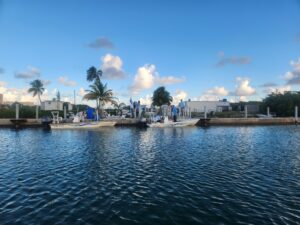
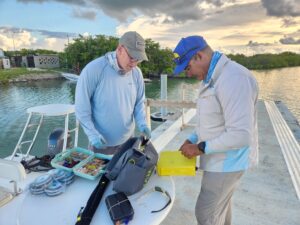
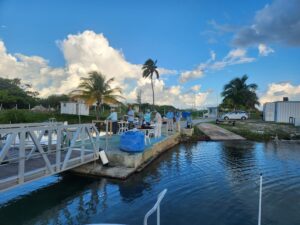
Overall the weather was good. It was warm but never felt uncomfortably hot. Most days were calm with only mild wind. In fact, there were some mornings when the water was as flat as a sheet of glass, motionless and quiet. On a few occasions I found myself wishing for wind. We always saw permit then, but they always saw us too. Each day squalls would pass through in the afternoon. Bands of rain would come down hard but move through quickly. Sometimes they moved over us and we got drentched. Other times they pasted us by, darkening the sky to either side of us as rain came down in sheets in the near distance. These storms brought with them wind but, it was temporary.
During these rain storms there was zero visability. That’s when you simply zip up your rain jacket, put your back to the wind and hunker down until it passes by. I found it refreshing and the rain was good at rincing off salt from the fly line and gear. Not a bad thing and certainly nothing that could be controlled. Weather. It is what it is.
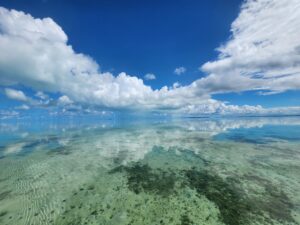
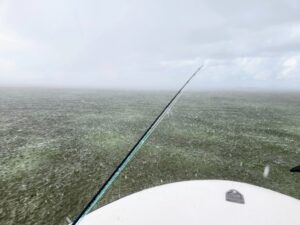
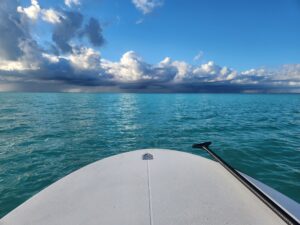
So how was the fishing? Good, very good. I would definitely return, do it again and am already making plans for 2024. It was different than other salt destinations I have fished including the Bahamas, Ascension Bay/Mexico, Xcalek/Mexico, Campeche/Mexico, Belize, Honduras, Costa Rica, the Maldives and the Seychelles. Cuba is quality verses quantity. Hands down the biggest bonefish I have ever seen, anywhere. Good sized permit and even some really big guys often cruising on their own. Not the masses or large schools you often find in other salt locations, but big fish at a steady pace.
My goal for the trip was to hunt permit. I wasn’t interested in tarpon or snook. I love bonefish but don’t enjoy casting into schools. I prefer sight fishing to singles and doubles. Mostly, I want permit. We would consistently see tails first thing in the morning. That was also when the water was usually dead flat without a single whisp of air moving. We saw permit, but they also saw us and spooked too easily. Getting a shot was tough and usually that’s all it was, one shot. Wind. Is there ever a happy medium?
After that first hour the permit seemed to disappear, even if the tide was still moving. Where they went will always be a mystery but that’s when our attention switched to bones, while keeping that permit rod ever ready. Occasionally we saw big schools but mostly it was sightings of singles, doubles or triples. They were BIG, all of them. I think the smallest bonefish I saw all week was 4lbs. On average they were between 6 and 8lbs with a 10 to 12lb monster showing up now and then. Cuban bonefish are not only long, but they are fat with broad shoulders. The pictures simply don’t do them justice. A few times I thought I was spotting junior tarpon when infact, they were bonefish.
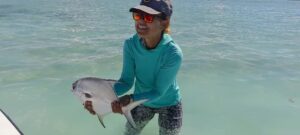 I brought my Winston Pure Salt 8wt and my new Zan Pro Hardy 11wt, as well as a Kyojin Tenkara rod. We were using shrimp and crab patterns including, mantris shrimp, avalon, spawning shrimp and flexo crabs usually paired with 16lb test. I also brought wire and some clouser and tarpon flies, just in case.
I brought my Winston Pure Salt 8wt and my new Zan Pro Hardy 11wt, as well as a Kyojin Tenkara rod. We were using shrimp and crab patterns including, mantris shrimp, avalon, spawning shrimp and flexo crabs usually paired with 16lb test. I also brought wire and some clouser and tarpon flies, just in case.
Most days we fished from the boat and there were periods when we saw nothing and didn’t make a cast for quite a long time, but again, we were focused on permit. Only one day did we wade. The tide was coming in and we walked a large flat for a few hours. That was the one day when I saw schools of bones- maybe 10-15 fish in each school, plowing through the shallow water in search of food. They were hungry and active and even when they broke apart or got spooked, they regrouped and after a short while would return. There were multiple schools too. You could almost stand in one place and just wait until a group would pass. Then, spot your lead fish, place a cast and hold on! Just fabulous.
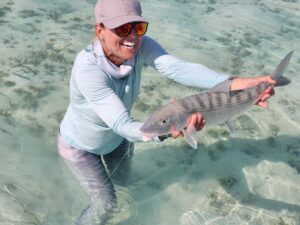
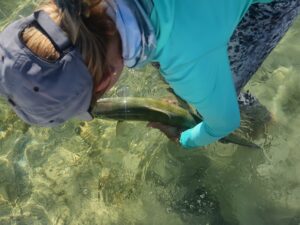
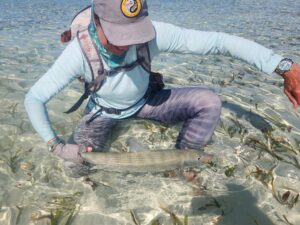
This was the day I decided to attempt to land a Cuban bone on my Zen Kyojin rod. As I said, these were very big fish. NOt just long, but heavy with true girth. The ground was fine packed sand and I was barefoot in salt tights. This is how I would choose to spend every day if I could. I set up the Kyojin with a 28ft Zen Fusion Line: Big and a 10ft Rio Shock Tip 16lb Tapered Leader. I knew it would be tough to hold onto one of these fish and was feeling a little nervous. Should I go up to 20lbs? I probably should have. They were feeding and it didn’t seem like the bigger line would have bothered them.
We walked the area quietly advancing. When the sun went behind a cloud we paused and stood motionless until it returned. The only other fish we spotted were a few tigger fish, also known as “tricky triggers” because not only do they spook easily, but they won’t move very far to eat something. A fly has to be put right in front of them. They move alot, have huge teeth for chomping custacians and are spooky. Triggers are considered difficult to hook let alone land. I have tried numerous times on the reel and never had success. I decided to try on tenkara.
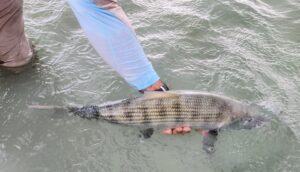
The first two trigger fish I spotted were moving too fast and were too far to really get any serious shots at. The third trigger I came upon was moving along slower and was feeding. The first cast was short. At least the trigger didn’t spook. The second cast I made was in the money and the fish followed, but turned. The next cast was right in front of him. I did two, maybe three small jig movements to the side (a tenkara imitation of a “strip”) and while the guide was urging me to continue strip, I felt the take and knew I was already on. I set to the side as hard as I could and prepared for the bolt. The trigger took me for a few short, fast, jogs and used his dish-shape body to pull against me, but I was fine and more importantly, so was the rod.
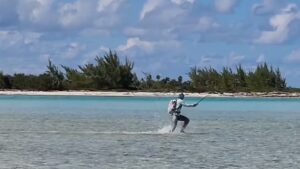
After a few moments I got hold of the line and started to pull the trigger fish in. Considering we were in salt, he was fairly cooperative. The trigger was all the way in and at my feet. I started to search for my phone so we could take a picture, being mindful of the fish’s teeth. Suddenly after relative calmness, the trigger got impatient and started to thrash. His teeth got hold of the leader and next thing I know, goodbye trigger fish. No grip and grin to show off. Disappointed? Massively. But still a very proud moment to not only have landed a trigger, but to have done it on tenkara. That was a huge accomplishment in my mind. It times like these when a cameraman would come in handy.
My Cuban bonefish attempt was similarly disappointing and symultaneously a proud moment. It ended in a “user error” mishap as well. I did not do what I preach (and typically practise). I made a rookie move and snapped the tip after a beautiful cast, hook set and play. I rushed the process instead of trusting the rod and in a hurry to land the fish, grabbed the line too high resulting in me pulling the tip section down and snapping it. Pop! Not surprising, after the tip snapped, the fish remained hooked and was still on the line. I made another rookie move when I drew up the fly line. I did it way too fast, frustrated with myself for snapping the tip section, and not paying attention to the fish still on the end of the line. The fast take-up caused the fish to spook and run. Unprepared, I held too hard and the fish snapped the 16lb test leader. Pop! It was a big, big bonefish and I made several silly mistakes. On the bright side I made the cast, placed the fly, stripped it and set it just fine. The rod held steady (another proud moment) and I played the fish well and was under control – until I grabbed the line way too high and made a mess of things. Ah, the highs and lows of fly fishing. Someone dear to me explained it well, he said it was all about controlling the adrenaline, the rush. He hit the nail on the head.
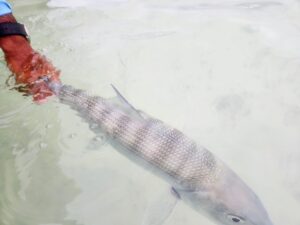
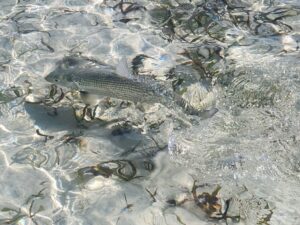
Cuba. I will return to do it all again – well, maybe not all of it. I have heard that the US will be offering a few more flight options to this magnificent country. Next time I hope to see more of it and make time to spend in either Havanna or Camaguay. I would absolutely return to Level Coral, Esmerelda and fish through Avalon. Heck, I would come back here to lounge by the poolside, sip rum and swim in the ocean. Hopefully the country will become more accessible. It is a fantastic destination for fishing and vacationing and a perfect place for parties with a mixture of anglers and non-anglers alike.
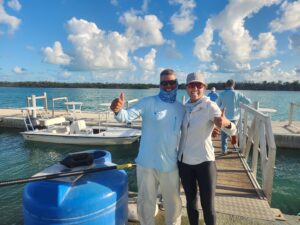
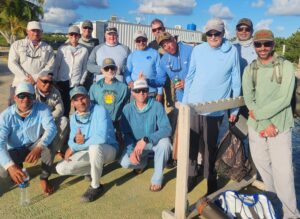
One more species was added to my list of tenkara landings. While I have no photo to share, there is some video and Nelson, my guide and Erik, my husband were witness. Fly fishing, tenkara fishing, teaches self-discipline and patience. Years ago I would have been frustrated and angry for the mistakes I made. These days I’m reflective and know there is always something to learn and improve upon. And now I know I can do it, so I’ll try it again. This is the stuff that keeps us coming back for more.
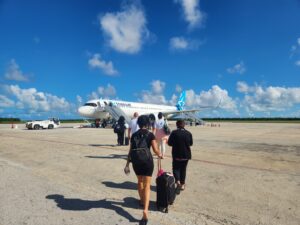
If you have specific questions about travel to and from Cuba, the fly fishing there, accomodations, food, gear, tenkara or any thing else, please feel free to contact me directly at karin@zenflyfishinggear.com.


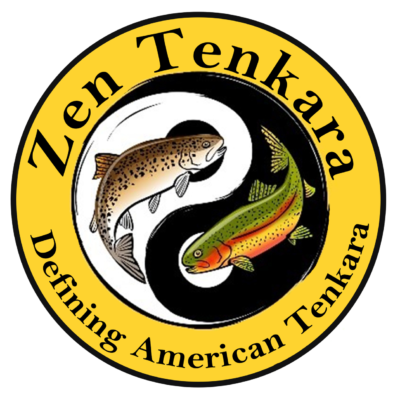

I have a question about hook style for tenkara should it be curved or a straight short hook? Thank you
Hi Mille, great question. Hook style or shape has less to do with tenkara and more to do with flies and fly tying in general. Curved and/or straight hooks are chosen to best imitate the insect they represent and its stage of life. Beyond that I personally don’t think hook shape impacts tenkara anglers in any way differently than it impacts a conventional fly anglers. When a pattern is tied, the hook chosen is one that best imitates the bug in a specific stage of life that is being imitated. At Zen we encourage angler to try all different fly patterns.